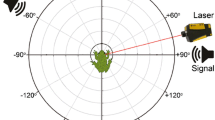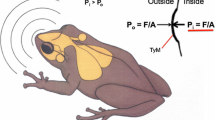Abstract
The mechanisms of hearing in the fire-bellied toad Bombina orientalis, an “earless” species of amphibian that lacks a standard tympanic middle ear, were studied using laser Doppler vibrometric and neurophysiological techniques. Laser vibrometry demonstrated that the anterolateral body wall overlying the lung is much more responsive to sound than the lateral head surface overlying the inner ear. Covering the lateral body wall with silicone grease dramatically decreased auditory midbrain sensitivity at all frequencies examined, elevating thresholds by 20–25 dB. Filling the lungs with oxygenated saline produced similar decrements in hearing sensitivity, and both manipulations strongly suggest that the lung is the primary route of sound reception in this species. The precise route of transfer of sound energy from the body wall and lungs to the inner ear remains unclear. The lung-based hearing system of “earless” fire-bellied toads may represent the retention of the first auditory mechanism used by early tetrapod vertebrates for detection of airborne sound.
Similar content being viewed by others
Author information
Authors and Affiliations
Additional information
Accepted: 10 December 1998
Rights and permissions
About this article
Cite this article
Hetherington, T., Lindquist, E. Lung-based hearing in an “earless” anuran amphibian. J Comp Physiol A 184, 395–401 (1999). https://doi.org/10.1007/s003590050338
Issue Date:
DOI: https://doi.org/10.1007/s003590050338




